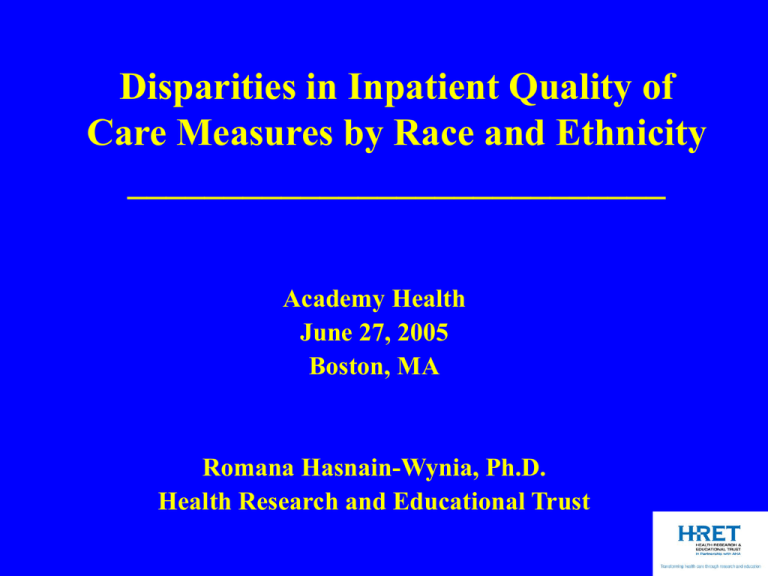Disparities in Inpatient Quality of Care Measures by Race and Ethnicity ____________________________
advertisement

Disparities in Inpatient Quality of Care Measures by Race and Ethnicity ____________________________ Academy Health June 27, 2005 Boston, MA Romana Hasnain-Wynia, Ph.D. Health Research and Educational Trust Co-authors • • • • • David W.Baker, MD, MPH Raj Behal, MD, MPH Joe Feinglass, PhD David Nerenz, PhD Joel S. Weissman, PhD PROJECT Linking Race and Ethnicity Data to Inpatient Quality of Care Measures Funding: The Commonwealth Fund Background • Hospital Quality Alliance – One of many efforts in CMS’s overall Hospital Quality Initiative to foster hospital quality improvement through a variety of quality measurement and improvement opportunities – >4,000 hospitals participating • Focus on Three Conditions – Acute Myocardial Infarction (AMI) – Heart Failure – Pneumonia Background • Evidence indicates that quality improvement efforts, when linked to data on race and ethnicity, can reduce disparities in care and improve quality – Mukamel and Mushlin “Quality of Care Information Makes a Difference: An Analysis of Market Share and Price Changes Following Publication of the New York State Cardiac Surgery Report Care.” Medical Care; 36:1998 – Schneider and Lieberman “Publicly Disclosed Information About the Quality of Healthcare: Response to the US Public.” Quality in Health Care. 2001 Background • Health care disparities should be brought into the mainstream quality assurance and continuous quality improvement discussions – Fiscella, et al. “Inequality in Quality: Addressing Socioeconomic, Racial, and Ethnic Disparities in Health Care. JAMA. 2000 Data Source • University Health System Consortium (UHC) – UHC is an alliance of academic health centers in the United States aimed at improving performance levels in clinical, operational, and financial areas. – UHC is collecting the quality measures for the three conditions with patient race and ethnicity information for 123 hospitals. – We are working with UHC to conduct analyses. – >7,000 cases per condition Methods • Create performance quintiles • Present data by % racial minorities seen at hospitals in each quintile • Exclusion if <50 total cases or <15 minority cases • Develop multivariate models – Model 1: unadjusted – Model 2: adjusted for individual characteristics, including co-morbidities, payer, age, gender – Model 3: Model 2 + adjusted for organizational effects (between hospital variation) Performance quintiles by % minority patients seen AMI measures % Minority 70 60 50 40 30 20 10 0 Smoking cessation counseling 1st quintile ASA at arrival 2nd quintile ASA at DC 3rd quintile PCI w/in 120 min 4th quintile Rate-based measures (higher quintile = better performance) 5th quintile Top and bottom quintiles by % minority patients seen AMI measures % Minority 70 60 50 40 30 20 10 0 Smoking cessation counseling ASA at arrival 1st quintile ASA at DC PCI w/in 120 min 5th quintile Rate-based measures (higher quintile = better performance) Top and bottom quintiles by % minority patients seen Heart Failure measures % Minority 70 60 50 40 30 20 10 0 Beta-blocker on arrival ACEI for LVSD DC instructions 1st quintile 5th quintile LVF assessment Rate-based measures (higher quintile = better performance) Top and bottom quintiles by % minority patients seen % Minority Pneumonia measures 60 50 40 30 20 10 0 O2 assessment Vaccination Blood cultures 1st quintile 5th quintile Smoking cessation Rate-based measures (higher quintile = better performance) Top and bottom quintiles by % minority patients seen % Minority Pneumonia measures 70 60 50 40 30 20 10 0 Abx w/in 8 hrs Abx w/in 4 Abx selection Abx selection hours in ICU non-ICU 1st quintile 5th quintile Rate-based measures (higher quintile = better performance) Top and bottom quintiles by % minority patients seen % Minority 70 60 50 40 1st quintile 5th quintile 30 20 10 0 time to thrombolysis Time to PCI Time to antibiotics Time-based measures (higher quintile = worse performance) Multivariate models adjusting for individual factors and hospital effects AMI Measures Model 1 Unadjusted Smoking Cessation -0.47 (-0.56—0.38) -0.47 (-0.58—0.37) -0.20 (-0.32—0.09) B-Blocker at arrival -0.18 (-0.30 --0.06) -0.20 (-.32—0.07) 0.03 (0.08—0.12) B-Blocker at discharge -0.29 (-0.39—0.19) -0.31 (-0.42—0.21) -0.05 (-0.14- 0.07) 0.05 (-0.16-0.21) 0.11 (-0.06-0.28) 0.23 (0.03-0.44) -0.21 (-0.34--0.08) -0.17 (-.030—0.04) 0.11 (-0.04-0.26) Aspirin at arrival Aspirin at discharge Model 2 Model 3 Adj. for demos, Adj. for between incl. co morbidities hospital effects Multivariate models adjusting for individual factors and hospital effects Heart Failure Measures Model 1 Unadjusted Model 2 Model 3 Adj. for demos, Adj. for between incl. co morbidities hospital effects Smoking Cessation -0.34 (-0.42—0.26) -0.33 (-0.41—0.25) -0.14 (-0.24—0.04) D/C Instructions -0.44 (-0.47—0.40) -0.41 (-0.45—0.37) -0.02 (-0.07-0.03) Assess LV Function -0.24 (-0.30—0.18) -0.25 (-0.31—0.18) 0.06 (-0.02-0.15) Multivariate models adjusting for individual factors and hospital effects Pneumonia Model 1 Unadjusted Measures Model 2 Model 3 Adj. for demos, Adj. for between incl. co morbidities hospital effects Smoking Cessation -0.60 (-0.70—0.50) -0.57 (-0.67—0.47) -0.20 (-0.33—0.08) Antibiotics w/in 4 hours -0.28 (-0.32—0.23) -0.16 (-0.21—0.13) 0.10 (0.05 – 0.15) Quality Challenges for the Underserved Where You Go Quality in Underserved Settings Who You Are Pt Centered Care for the Underserved Slide by A. Beal Considerations • There is some within hospital variation • There is clearly variation between hospitals with the data showing that performance on some of the CMS quality measures is poorer in hospitals serving a large number of minorities • Examine hospital characteristics (payer mix, urban location, age of facility, etc…) • Be careful. For example, what will be the outcome of Pay for Performance? • Should quality improvement efforts focus on hospitals serving a large % of minority patients. Focus on factors amenable to improvement. Policy Focus “Policies designed to equalize patients’ treatment within hospitals will not erase disparities at the national level. What is necessary to erase health care disparities is to implement national policies designed to improve the overall treatment of all patients, which in turn will have a disproportionate effect on reducing racial,ethnic,and geographic disparities in health care and health outcomes.” K. Baicker, A. Chandra, and J. S. Skinner (2005).“Geographic Variation in Health Care and the Problem of Measuring Racial Disparities.” Perspectives in Biology and Medicine.






